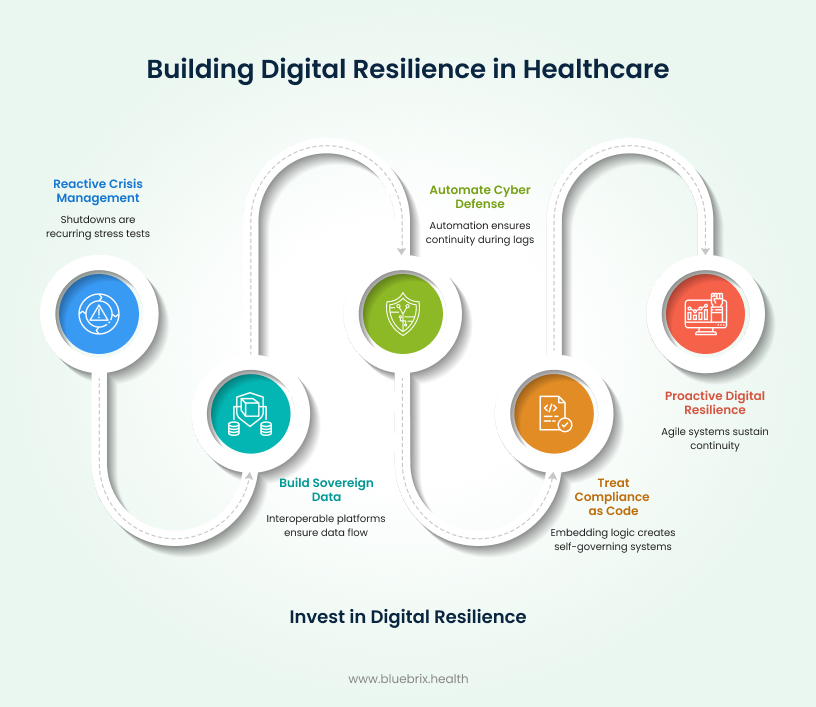
Every time Congress edges toward a shutdown, the U.S. healthcare system finds itself holding its breath. What looks like a political standoff on paper translates into very real operational disruption on the ground for hospitals, payers, research networks, and the communities that depend on them.
Yes, core programs like Medicare and Medicaid continue to function, but the discretionary-funded services that drive innovation, coordination, and quality often come to a halt. Telehealth flexibilities stall. Research grants freeze. Cybersecurity oversight slows down. The result is a silent ripple that exposes how tightly healthcare’s daily functioning and its future resilience are tied to its technology backbone.
The recent shutdown made one thing clear – post-shutdown recovery is more of a technology test than administrative restart! The strength of your digital infrastructure determines how quickly, efficiently, and safely you can bounce back.
When technology becomes the first casualty
When government operations pause, the immediate effects suspended telehealth programs and that grabbed headlines. But the deeper damage happens quietly across systems that depend on continuous data flow, security monitoring, and regulatory oversight.
1. Cybersecurity exposure and data integrity risks
Federal agencies like CISA and CMS play a crucial behind-the-scenes role in safeguarding healthcare infrastructure. When their operations slow or stop, so does the protective layer around thousands of healthcare organizations.
- Intelligence gaps: Many smaller organizations rely on CISA’s free scanning and threat updates. During shutdowns, that visibility disappears, leaving vulnerabilities unchecked.
- Regulatory lag: With audits and compliance reviews paused, organizations face a growing backlog of updates once normal operations resume pulling attention away from modernization projects.
2. Innovation gridlock and regulatory stagnation
Shutdowns halt progress across agencies like the FDA and NIH, delaying clinical research, device approvals, and essential funding.
- Lost time-to-market: Every week of pause can mean months of downstream delay for MedTech partnerships and clinical trials.
- Frozen infrastructure planning: Providers postpone technology upgrades or new implementations when funding and reimbursement adjustments are uncertain widening the digital gap between large systems and smaller or rural providers.
Rethinking recovery: from reactive crisis management to digital resilience
For healthcare leaders, the lesson is clear: shutdowns are not unexpected anomalies — they are recurring stress tests. The question is no longer if they’ll happen, but how prepared your organization is when they do.

Building resilience means investing ahead of crisis — in technology architectures that are agile, independent, and able to sustain continuity even when federal systems go offline.
1. Build sovereign data foundations
Data must flow securely and consistently even if national systems don’t. That requires interoperable, open platforms that integrate across internal networks, affiliates, and local public health agencies. When federal APIs or data-sharing updates freeze, your data shouldn’t.
2. Automate cyber defense
Don’t wait for a federal advisory to act. Automation-driven cybersecurity, from immutable data backups to autonomous incident response, ensures continuity even during oversight lags. Immutable backups, in particular, provide a safeguard against ransomware and accidental data loss, giving leaders confidence that recovery is possible without federal intervention.
3. Treat compliance as code
Embedding compliance logic directly into system design (for example, automating HIPAA rule validation during code deployment) creates self-governing systems. This approach reduces dependency on external audits or delayed regulatory updates which is a major advantage when operations slow down.
A model to learn from: how financial services mastered operational resilience
After the 2008 financial crisis, the Bank of England introduced an “Operational Resilience” framework — one that required financial institutions to prove they could sustain critical business services even during extreme disruption.
Instead of merely focusing on uptime or disaster recovery, firms had to:
- Map critical services and identify every dependency including people, data, vendors, and systems.
- Set impact tolerances by defining how long a disruption could last before causing unacceptable harm.
- Stress test to tolerance for continuously verifying that essential operations could recover within that threshold.
This shift changed how banks viewed technology: not as overhead, but as the foundation of trust and continuity.
The healthcare parallel: safeguarding the continuity of care
For healthcare, the parallel is obvious. Our “Important Business Services” aren’t payment processing or trading platforms; they’re patient lives and coordinated care pathways. A shutdown disrupts more than data or funding; it disrupts care continuity. When grants freeze or systems stall, it’s often the high-acuity, chronically ill patients who face the consequences – missed follow-ups, delayed diagnostics, or unnecessary readmissions.
Technology preparedness is what keeps that from happening.
- Automate what humans can’t cover: AI-driven care coordination engines can identify high-risk patients and trigger alerts, outreach, or triage protocols automatically ensuring continuity even when federally supported staff or data flows are interrupted.
- Reduce data dependencies: Interoperable and federated data systems that pull from commercial labs, HIEs, and internal sources ensure that eligibility checks, medication lists, and care plans stay accurate even if national databases go dark.
- Redefine impact tolerance: Measure resilience not by uptime, but by outcomes. For example, ensuring that a remote monitoring system for CHF patients doesn’t exceed four hours of downtime during a shutdown directly links tech readiness that avoids readmissions and cost control.
The takeaway is simple: technology isn’t a backup plan but your organization’s lifeline.
Quick self-assessment: is your organization technology-ready for the next shutdown?
Use this checklist to gauge your current level of preparedness (not for compliance, but for continuity).
1. Data resilience
- Can your critical data systems function if federal APIs or databases go offline?
- Do you have interoperable, open data exchanges with affiliates and local partners?
- Are immutable backups in place and tested regularly?
2. Cyber defense readiness
- Do you have automated threat detection and incident response workflows?
- Can your system isolate and recover from a cyberattack without external support?
- Are employees trained for cybersecurity continuity during federal downtimes?
3. Compliance & governance
- Is compliance embedded in your system architecture (Compliance-as-Code)?
- Do you have visibility into regulatory updates paused during shutdowns?
- Can you continue audits and documentation autonomously?
4. Care continuity systems
- Can care coordination workflows continue without manual triggers or federal data streams?
- Do your digital tools proactively flag and engage high-risk patients during disruptions?
- Have you defined impact tolerances for critical services (e.g., remote monitoring downtime limits)?
5. Leadership & strategy
- Is technology resilience part of your board-level risk discussions?
- Do you have a documented “operational resilience plan” with defined recovery thresholds?
If you checked fewer than 8 boxes, your organization may be more dependent on federal infrastructure than you realize. Now is the time to strengthen digital independence, before the next shutdown tests it again. Let’s resolve your dependency.
Turning shutdowns into strategic opportunities
A shutdown exposes every hidden dependency, every fragile workflow, and every area where systems lean too heavily on federal infrastructure. That can be frustrating or it can be an opportunity to future-proof operations.
Healthcare leaders who treat shutdowns as stress tests rather than disruptions can use the insights to re-architect for resilience:
- Build technology that operates autonomously.
- Embed compliance into systems.
- Protect and own your data.
- Redefine resilience in clinical, not technical, terms.
Because ultimately, technology preparedness isn’t about efficiency but about protecting the continuity of care, avoiding high-cost breakdowns, and sustaining the clinical mission through uncertainty.
Shutdowns may come and go. But organizations that invest in resilience today will be the ones still delivering connected, coordinated care tomorrow, no matter what’s happening in Washington. Future-proof your care coordination systems now. Let’s discuss how we can reinforce your operational resilience.